Sleep Apnea and Heart Failure—Current State-of-The-Art
Abstract
1. Introduction
2. Methods
3. Introduction to Obstructive and Central Sleep Apnea
3.1. Obstructive Sleep Apnea
3.2. Central Sleep Apnea
4. Risk Factors and Demographics of Sleep Apnea and Heart Failure
4.1. Obesity
4.2. Ethanol Consumption/Smoking
4.3. Opioid Use
4.4. Age
4.5. Gender
5. Cardiac Implications of Sleep Apnea
5.1. Fluid Balance
5.2. Loop Gain
5.3. Intrathoracic Pressure Dynamics
5.4. Intermittent Hypoxia
5.5. Adrenergic Response
6. OSA and Cardiac Arrhythmogenesis
6.1. Atrial Fibrillation
6.2. Ventricular Arrhythmias
7. The Role of CPAP and Adaptive Servo-Ventilation in Sleep Apnea Management
7.1. Efficacy of CPAP in Cardiac Function and Symptom Improvement
7.2. Challenges in CPAP Adherence and Its Clinical Implications
7.3. OSA and Heart Failure Readmissions: Assessing CPAP’s Role in Reducing Hospitalizations
7.4. The Effectiveness and Limitations of CPAP in Managing CSA in HF Patients
7.5. Evaluation of Clinical and Behavioral Treatment Strategies for CPAP Adherence
7.6. Long-Term Impact of ASV Therapy
8. Sleep Apnea in Heart Failure: Evaluating Morbidity and Mortality
8.1. Mortality Trends in HF Patients with Untreated Moderate to Severe OSA
8.2. Overlap Syndrome
8.3. OSA Symptom Subtypes and Their Impact on Heart Failure Risk
8.4. Linking OSA Severity to Cardiovascular Outcomes
9. A Comprehensive Approach to Sleep Apnea: Diagnosis and Management
9.1. Current Methods of Diagnosing Sleep Apnea
9.2. Advancements in Sleep Apnea Diagnosis through Technology
9.3. Emerging Non-CPAP Therapies for OSA Management
9.4. Management of CSA in HF
10. Conclusions
11. Future Research Directions in SDB and Heart Failure
Author Contributions
Funding
Conflicts of Interest
References
- Dharia, S.M.; Brown, L.K. Epidemiology of Sleep-Disordered Breathing and Heart Failure: What Drives What. Curr. Heart Fail. Rep. 2017, 14, 351–364. [Google Scholar] [CrossRef]
- Tondo, P.; Fanfulla, F.; Sabato, R.; Scioscia, G.; Foschino Barbaro, M.P.; Lacedonia, D. Obstructive sleep apnoea-hypopnoea syndrome: State of the art. Minerva Med. 2023, 114, 74–89. [Google Scholar] [CrossRef]
- Martynowicz, H.; Wichniak, A.; Wieckiewicz, M. Sleep disorders and cardiovascular risk: Focusing on sleep fragmentation. Dent. Med. Probl. 2024, 61, 1–3. [Google Scholar] [CrossRef]
- Bradley, T.D.; Floras, J.S. Sleep Apnea and Heart Failure: Part I: Obstructive Sleep Apnea. Circulation 2003, 107, 1671–1678. [Google Scholar] [CrossRef]
- Bradley, T.D.; Floras, J.S. Sleep Apnea and Heart Failure: Part II: Central Sleep Apnea. Circulation 2003, 107, 1822–1826. [Google Scholar] [CrossRef]
- Wolk, R.; Kara, T.; Somers, V.K. Sleep-Disordered Breathing and Cardiovascular Disease. Circulation 2003, 108, 9–12. [Google Scholar] [CrossRef]
- Gać, P.; Urbanik, D.; Macek, P.; Martynowicz, H.; Mazur, G.; Poręba, R. Coexistence of cardiovascular risk factors and obstructive sleep apnoea in polysomnography. Respir. Physiol. Neurobiol. 2022, 295, 103782. [Google Scholar] [CrossRef]
- Lattimore, J.-D.L.; Celermajer, D.S.; Wilcox, I. Obstructive sleep apnea and cardiovascular disease. J. Am. Coll. Cardiol. 2003, 41, 1429–1437. [Google Scholar] [CrossRef]
- Simou, E.; Britton, J.; Leonardi-Bee, J. Alcohol and the risk of sleep apnoea: A systematic review and meta-analysis. Sleep Med. 2018, 42, 38–46. [Google Scholar] [CrossRef]
- Krishnan, V.; Dixon-Williams, S.; Thornton, J.D. Where There Is Smoke…There Is Sleep Apnea. Chest 2014, 146, 1673–1680. [Google Scholar] [CrossRef]
- Ahmad, A.; Ahmad, R.; Meteb, M.; Ryan, C.M.; Leung, R.S.; Montandon, G.; Luks, V.; Kendzerska, T. The relationship between opioid use and obstructive sleep apnea: A systematic review and meta-analysis. Sleep Med. Rev. 2021, 58, 101441. [Google Scholar] [CrossRef]
- Gabbay, I.E.; Lavie, P. Age- and gender-related characteristics of obstructive sleep apnea. Sleep Breath. 2012, 16, 453–460. [Google Scholar] [CrossRef]
- Roca, G.Q.; Redline, S.; Claggett, B.; Bello, N.; Ballantyne, C.M.; Solomon, S.D.; Shah, A.M. Sex-Specific Association of Sleep Apnea Severity With Subclinical Myocardial Injury, Ventricular Hypertrophy, and Heart Failure Risk in a Community-Dwelling Cohort: The Atherosclerosis Risk in Communities–Sleep Heart Health Study. Circulation 2015, 132, 1329–1337. [Google Scholar] [CrossRef]
- White, L.H.; Bradley, T.D. Role of nocturnal rostral fluid shift in the pathogenesis of obstructive and central sleep apnoea. J. Physiol. 2013, 591, 1179–1193. [Google Scholar] [CrossRef]
- Javaheri, S.; Badr, M.S. Central sleep apnea: Pathophysiologic classification. Sleep 2023, 46, zsac113. [Google Scholar] [CrossRef]
- Kasai, T. Sleep apnea and heart failure. J. Cardiol. 2012, 60, 78–85. [Google Scholar] [CrossRef]
- Baguet, J.-P.; Barone-Rochette, G.; Tamisier, R.; Levy, P.; Pépin, J.-L. Mechanisms of cardiac dysfunction in obstructive sleep apnea. Nat. Rev. Cardiol. 2012, 9, 679–688. [Google Scholar] [CrossRef]
- Arias, M.A.; García-Río, F.; Alonso-Fernández, A.; Mediano, O.; Martínez, I.; Villamor, J. Obstructive Sleep Apnea Syndrome Affects Left Ventricular Diastolic Function: Effects of Nasal Continuous Positive Airway Pressure in Men. Circulation 2005, 112, 375–383. [Google Scholar] [CrossRef]
- Garvey, J.F.; Taylor, C.T.; McNicholas, W.T. Cardiovascular disease in obstructive sleep apnoea syndrome: The role of intermittent hypoxia and inflammation. Eur. Respir. J. 2009, 33, 1195–1205. [Google Scholar] [CrossRef]
- Shamsuzzaman, A.S.M.; Gersh, B.J.; Somers, V.K. Obstructive sleep apnea: Implications for cardiac and vascular disease. JAMA 2003, 290, 1906–1914. [Google Scholar] [CrossRef]
- Tondo, P.; Fanfulla, F.; Scioscia, G.; Sabato, R.; Salvemini, M.; De Pace, C.C.; Foschino Barbaro, M.P.; Lacedonia, D. The Burden of Respiratory Alterations during Sleep on Comorbidities in Obstructive Sleep Apnoea (OSA). Brain Sci. 2022, 12, 1359. [Google Scholar] [CrossRef] [PubMed]
- Lobo, D.M.L.; Trevizan, P.F.; Toschi-Dias, E.; Oliveira, P.A.; Piveta, R.B.; Almeida, D.R.; Mady, C.; Bocchi, E.A.; Lorenzi-Filho, G.; Middlekauff, H.R.; et al. Sleep-Disordered Breathing Exacerbates Muscle Vasoconstriction and Sympathetic Neural Activation in Patients with Systolic Heart Failure. Circ. Heart Fail. 2016, 9, e003065. [Google Scholar] [CrossRef] [PubMed]
- Gami, A.S.; Hodge, D.O.; Herges, R.M.; Olson, E.J.; Nykodym, J.; Kara, T.; Somers, V.K. Obstructive Sleep Apnea, Obesity, and the Risk of Incident Atrial Fibrillation. J. Am. Coll. Cardiol. 2007, 49, 565–571. [Google Scholar] [CrossRef] [PubMed]
- Marinheiro, R.; Parreira, L.; Amador, P.; Mesquita, D.; Farinha, J.; Fonseca, M.; Duarte, T.; Lopes, C.; Fernandes, A.; Caria, R. Ventricular Arrhythmias in Patients with Obstructive Sleep Apnea. Curr. Cardiol. Rev. 2018, 15, 64–74. [Google Scholar] [CrossRef]
- Hall, A.B.; Ziadi, M.C.; Leech, J.A.; Chen, S.-Y.; Burwash, I.G.; Renaud, J.; deKemp, R.A.; Haddad, H.; Mielniczuk, L.M.; Yoshinaga, K.; et al. Effects of Short-Term Continuous Positive Airway Pressure on Myocardial Sympathetic Nerve Function and Energetics in Patients With Heart Failure and Obstructive Sleep Apnea: A Randomized Study. Circulation 2014, 130, 892–901. [Google Scholar] [CrossRef] [PubMed]
- Shivalkar, B.; Van De Heyning, C.; Kerremans, M.; Rinkevich, D.; Verbraecken, J.; De Backer, W.; Vrints, C. Obstructive Sleep Apnea Syndrome. J. Am. Coll. Cardiol. 2006, 47, 1433–1439. [Google Scholar] [CrossRef]
- Xu, L.; Keenan, B.T.; Maislin, D.; Gislason, T.; Benediktsdóttir, B.; Gudmundsdóttir, S.; Gardarsdottir, M.; Staley, B.; Pack, F.M.; Guo, X.; et al. Effect of Obstructive Sleep Apnea and Positive Airway Pressure Therapy on Cardiac Remodeling as Assessed by Cardiac Biomarker and Magnetic Resonance Imaging in Nonobese and Obese Adults. Hypertension 2021, 77, 980–992. [Google Scholar] [CrossRef]
- Mehra, R. Obstructive Sleep Apnea and Cardiovascular Disease in Adults. Available online: https://www.uptodate.cn/home (accessed on 1 January 2024).
- Holt, A.; Bjerre, J.; Zareini, B.; Koch, H.; Tønnesen, P.; Gislason, G.H.; Nielsen, O.W.; Schou, M.; Lamberts, M. Sleep Apnea, the Risk of Developing Heart Failure, and Potential Benefits of Continuous Positive Airway Pressure (CPAP) Therapy. J. Am. Heart Assoc. 2018, 7, e008684. [Google Scholar] [CrossRef]
- McEvoy, R.D.; Antic, N.A.; Heeley, E.; Luo, Y.; Ou, Q.; Zhang, X.; Mediano, O.; Chen, R.; Drager, L.F.; Liu, Z.; et al. CPAP for Prevention of Cardiovascular Events in Obstructive Sleep Apnea. N. Engl. J. Med. 2016, 375, 919–931. [Google Scholar] [CrossRef]
- Sommerfeld, A.; Althouse, A.D.; Prince, J.; Atwood, C.W.; Mulukutla, S.R.; Hickey, G.W. Obstructive sleep apnea is associated with increased readmission in heart failure patients. Clin. Cardiol. 2017, 40, 873–878. [Google Scholar] [CrossRef]
- Malhotra, A.; Cole, K.V.; Malik, A.S.; Pépin, J.; Sert Kuniyoshi, F.H.; Cistulli, P.A.; Benjafield, A.V.; Somers, V.K.; Cistulli, P.; Malhotra, A.; et al. Positive Airway Pressure Adherence and Health Care Resource Utilization in Patients With Obstructive Sleep Apnea and Heart Failure With Reduced Ejection Fraction. J. Am. Heart Assoc. 2023, 12, e028732. [Google Scholar] [CrossRef] [PubMed]
- Lyons, O.D.; Floras, J.S.; Logan, A.G.; Beanlands, R.; Cantolla, J.D.; Fitzpatrick, M.; Fleetham, J.; John Kimoff, R.; Leung, R.S.T.; Lorenzi Filho, G.; et al. Design of the effect of adaptive servo-ventilation on survival and cardiovascular hospital admissions in patients with heart failure and sleep apnoea: The ADVENT-HF trial. Eur. J. Heart Fail. 2017, 19, 579–587. [Google Scholar] [CrossRef] [PubMed]
- Donovan, L.M.; Boeder, S.; Malhotra, A.; Patel, S.R. New developments in the use of positive airway pressure for obstructive sleep apnea. J. Thorac. Dis. 2015, 7, 1323–1342. [Google Scholar] [PubMed]
- Cowie, M.R.; Woehrle, H.; Wegscheider, K.; Angermann, C.; d’Ortho, M.-P.; Erdmann, E.; Levy, P.; Simonds, A.K.; Somers, V.K.; Zannad, F.; et al. Adaptive Servo-Ventilation for Central Sleep Apnea in Systolic Heart Failure. N. Engl. J. Med. 2015, 373, 1095–1105. [Google Scholar] [CrossRef] [PubMed]
- Tamisier, R.; Damy, T.; Bailly, S.; Davy, J.-M.; Verbraecken, J.; Lavergne, F.; Palot, A.; Goutorbe, F.; d’Ortho, M.-P.; Pépin, J.L. Adaptive servo ventilation for sleep apnoea in heart failure: The FACE study 3-month data. Thorax 2022, 77, 178–185. [Google Scholar] [CrossRef] [PubMed]
- Wang, H.; Parker, J.D.; Newton, G.E.; Floras, J.S.; Mak, S.; Chiu, K.-L.; Ruttanaumpawan, P.; Tomlinson, G.; Bradley, T.D. Influence of Obstructive Sleep Apnea on Mortality in Patients With Heart Failure. J. Am. Coll. Cardiol. 2007, 49, 1625–1631. [Google Scholar] [CrossRef] [PubMed]
- Tondo, P.; Scioscia, G.; Sabato, R.; Leccisotti, R.; Hoxhallari, A.; Sorangelo, S.; Mansueto, G.; Campanino, T.; Carone, M.; Foschino Barbaro, M.P.; et al. Mortality in obstructive sleep apnea syndrome (OSAS) and overlap syndrome (OS): The role of nocturnal hypoxemia and CPAP compliance. Sleep Med. 2023, 112, 96–103. [Google Scholar] [CrossRef] [PubMed]
- Mazzotti, D.R.; Keenan, B.T.; Lim, D.C.; Gottlieb, D.J.; Kim, J.; Pack, A.I. Symptom Subtypes of Obstructive Sleep Apnea Predict Incidence of Cardiovascular Outcomes. Am. J. Respir. Crit. Care Med. 2019, 200, 493–506. [Google Scholar] [CrossRef] [PubMed]
- Yasir, M.; Pervaiz, A.; Sankari, A. Cardiovascular Outcomes in Sleep-Disordered Breathing: Are We Under-estimating? Front. Neurol. 2022, 13, 801167. [Google Scholar] [CrossRef]
- Cowie, M.R.; Linz, D.; Redline, S.; Somers, V.K.; Simonds, A.K. Sleep Disordered Breathing and Cardiovascular Disease. J. Am. Coll. Cardiol. 2021, 78, 608–624. [Google Scholar] [CrossRef]
- Fudim, M.; Shahid, I.; Emani, S.; Klein, L.; Dupuy-McCauley, K.L.; Zieroth, S.; Mentz, R.J. Evaluation and Treatment of Central Sleep Apnea in Patients with Heart Failure. Curr. Probl. Cardiol. 2022, 47, 101364. [Google Scholar] [CrossRef] [PubMed]
- Bazoukis, G.; Bollepalli, S.C.; Chung, C.T.; Li, X.; Tse, G.; Bartley, B.L.; Batool-Anwar, S.; Quan, S.F.; Armoundas, A.A. Application of artificial intelligence in the diagnosis of sleep apnea. J. Clin. Sleep Med. 2023, 19, 1337–1363. [Google Scholar] [CrossRef] [PubMed]
- Pépin, J.-L.; Eastwood, P.; Eckert, D.J. Novel avenues to approach non-CPAP therapy and implement comprehensive obstructive sleep apnoea care. Eur. Respir. J. 2022, 59, 2101788. [Google Scholar] [CrossRef] [PubMed]
- Lee, Y.-C.; Lu, C.-T.; Chuang, L.-P.; Lee, L.-A.; Fang, T.-J.; Cheng, W.-N.; Li, H.-Y. Pharmacotherapy for obstructive sleep apnea—A systematic review and meta-analysis of randomized controlled trials. Sleep Med. Rev. 2023, 70, 101809. [Google Scholar] [CrossRef] [PubMed]
- Carrasco-Llatas, M.; O’Connor-Reina, C.; Calvo-Henríquez, C. The Role of Myofunctional Therapy in Treating Sleep-Disordered Breathing: A State-of-the-Art Review. Int. J. Environ. Res. Public Health 2021, 18, 7291. [Google Scholar] [CrossRef]
- Wang, Y.; Schöbel, C.; Penzel, T. Management of Obstructive Sleep Apnea in Patients With Heart Failure. Front. Med. 2022, 9, 803388. [Google Scholar] [CrossRef]
- Maniaci, A.; Di Luca, M.; Lechien, J.R.; Iannella, G.; Grillo, C.; Grillo, C.M.; Merlino, F.; Calvo-Henriquez, C.; De Vito, A.; Magliulo, G.; et al. Lateral pharyngoplasty vs. traditional uvulopalatopharyngoplasty for patients with OSA: Systematic review and meta-analysis. Sleep Breath. 2022, 26, 1539–1550. [Google Scholar] [CrossRef] [PubMed]
- Lorusso, F.; Dispenza, F.; Sireci, F.; Immordino, A.; Immordino, P.; Gallina, S. Management of pharyngeal collapse in patients affected by moderate obstructive sleep apnoea syndrome. Acta Otorhinolaryngol. Ital. 2022, 42, 273–280. [Google Scholar] [CrossRef]
- Badr, M.S.; Javaheri, S. Central Sleep Apnea: A Brief Review. Curr. Pulmonol. Rep. 2019, 8, 14–21. [Google Scholar] [CrossRef]
- Javaheri, S.; Somers, V.K. Cardiovascular diseases and sleep apnea. In Handbook of Clinical Neurology; Elsevier: Amsterdam, The Netherlands, 2011; Volume 98, pp. 327–345. ISBN 978-0-444-52006-7. [Google Scholar]
- Sutherland, K.; Kairaitis, K.; Yee, B.J.; Cistulli, P.A. From CPAP to tailored therapy for obstructive sleep Apnoea. Multidiscip. Respir. Med. 2018, 13, 44. [Google Scholar] [CrossRef]
- Pinilla, L.; Barbé, F.; De Gonzalo-Calvo, D. MicroRNAs to guide medical decision-making in obstructive sleep apnea: A review. Sleep Med. Rev. 2021, 59, 101458. [Google Scholar] [CrossRef] [PubMed]

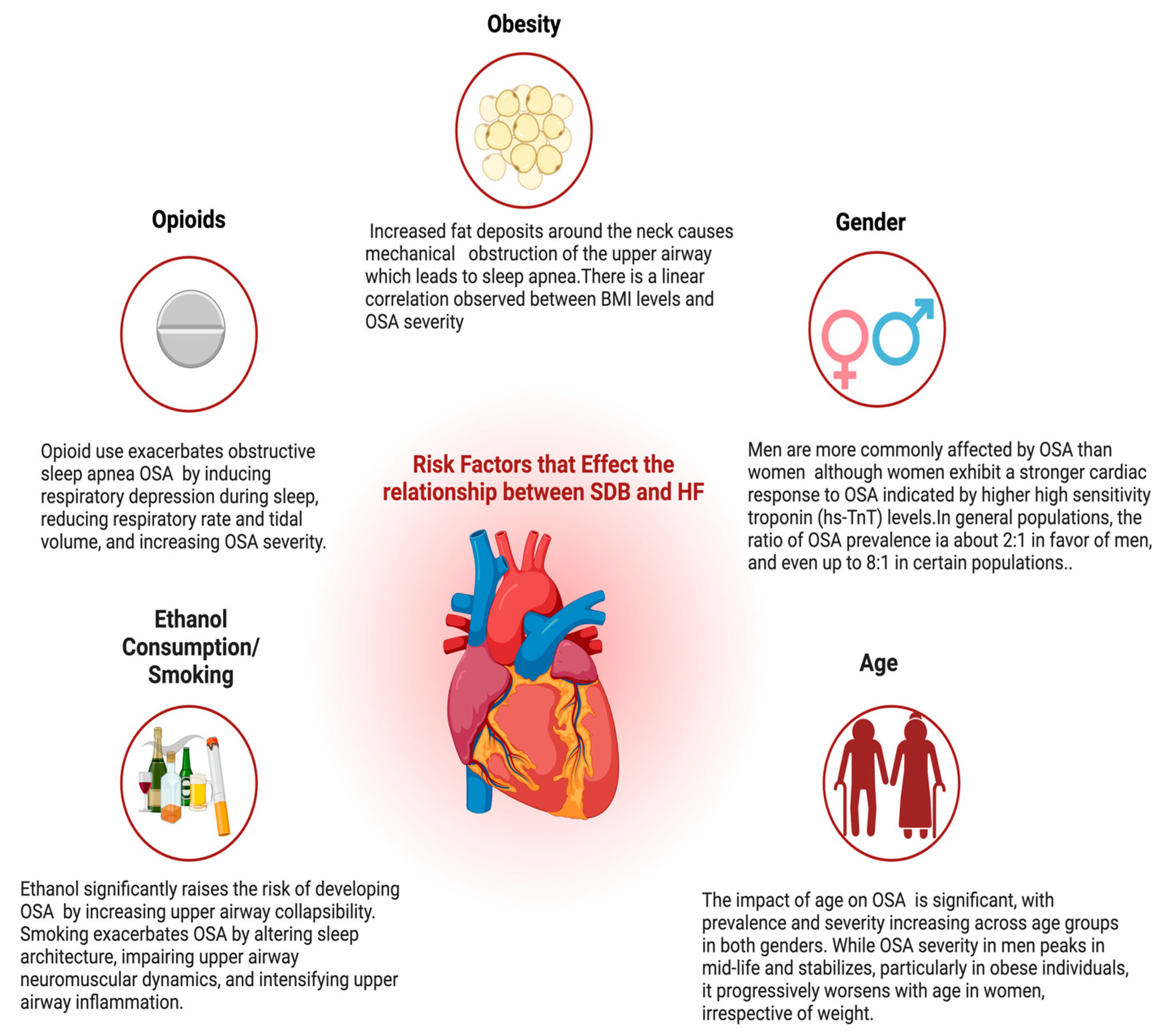
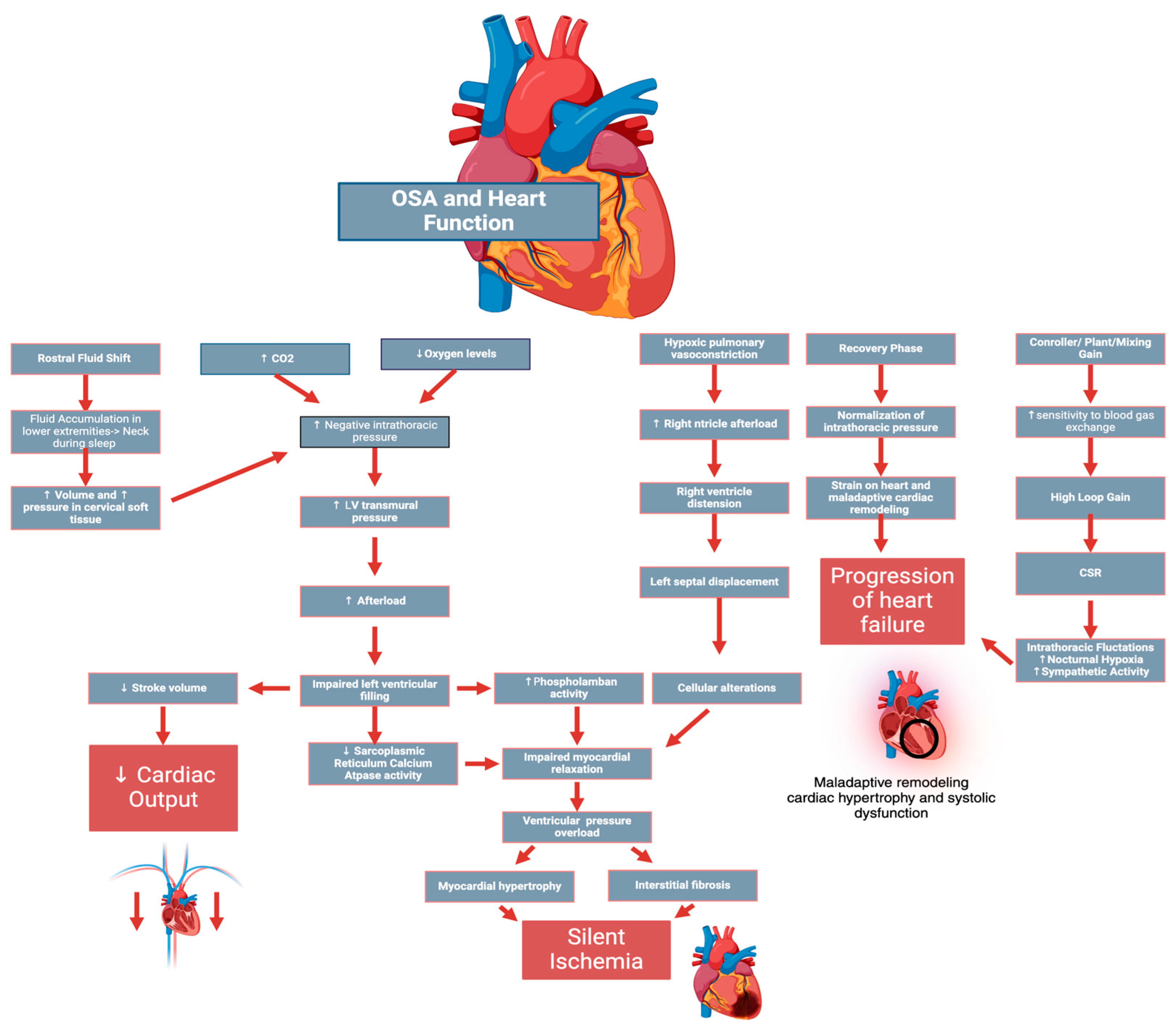
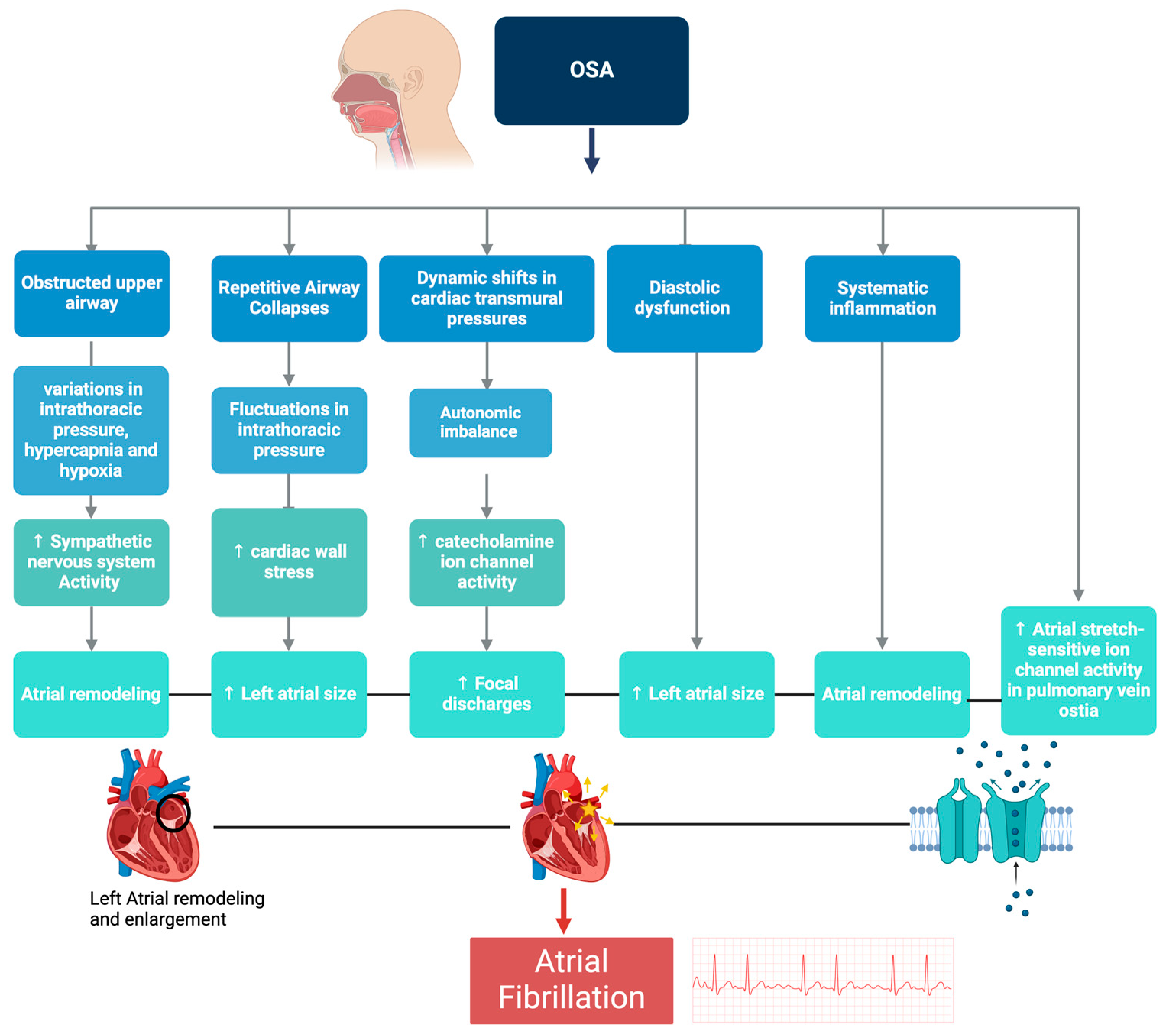

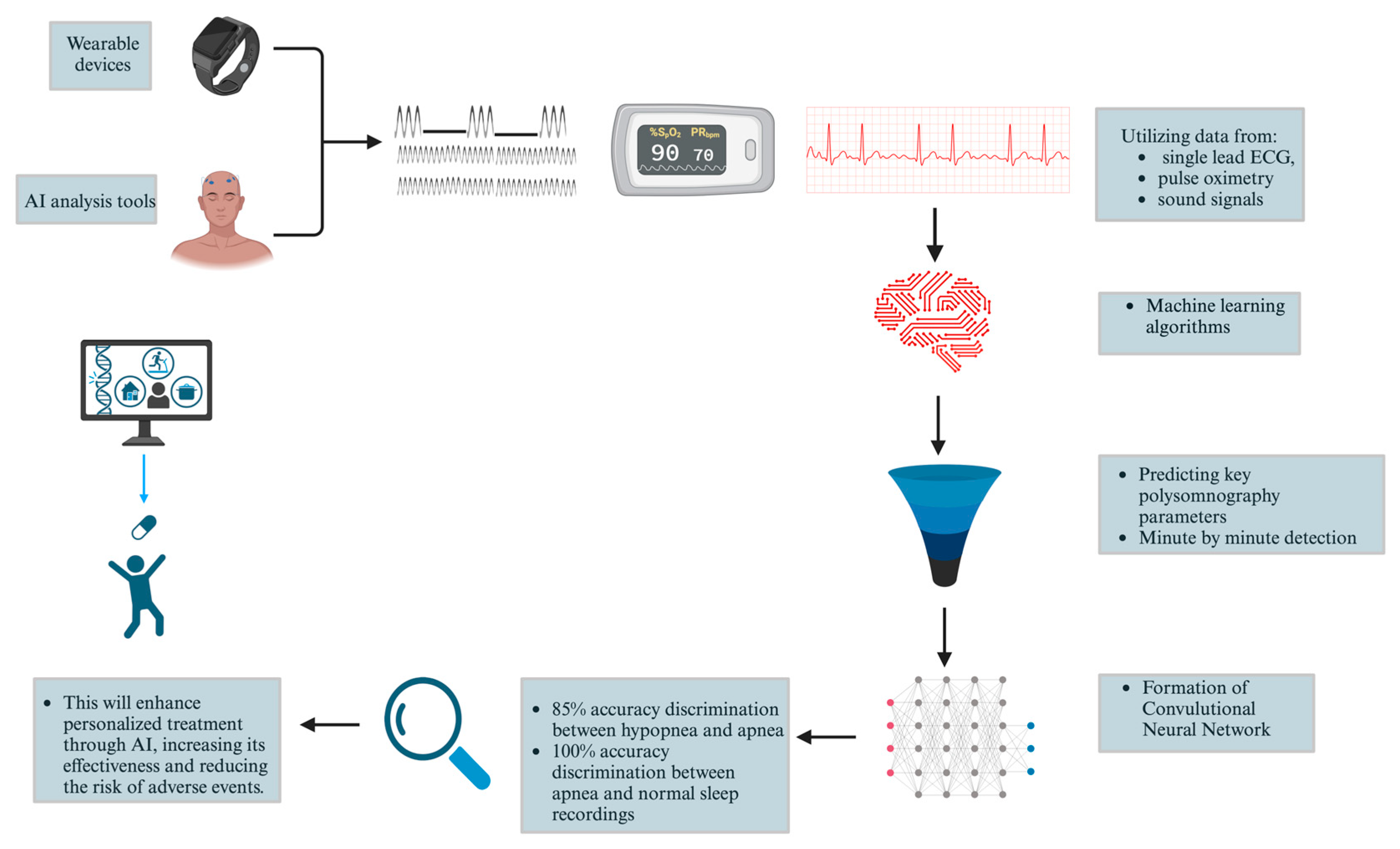
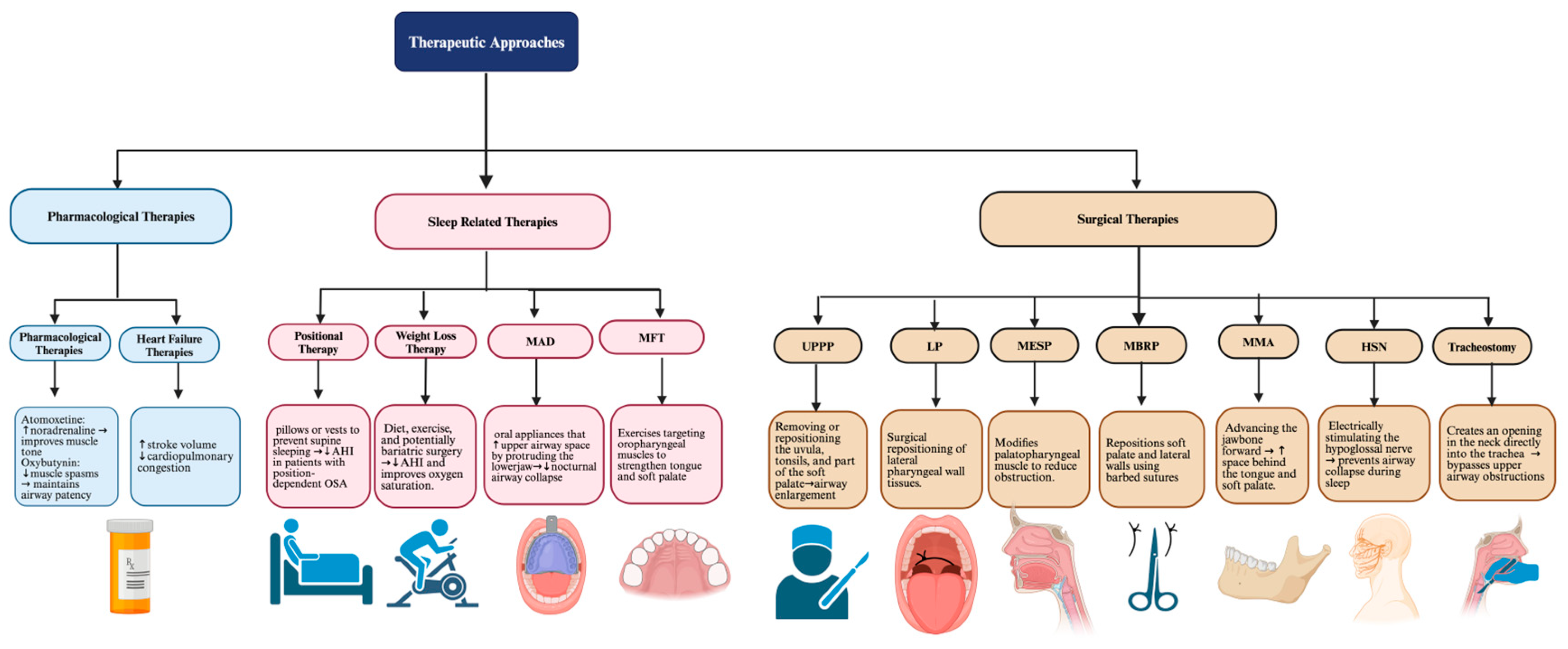
| Reference/Study | Patient Group | Key Findings |
|---|---|---|
| Hall et al. [25] | OSA and HF | CPAP treatment significantly improved myocardial sympathetic nerve function, as evidenced by increased hydroxyephedrine retention. It also led to improvements in work metabolic index and systolic blood pressure in patients with apnea–hypopnea index > 20 events per hour. |
| Shivalkar et al. [26] | Severe OSA without cardiac or pulmonary disease | CPAP treatment for six months led to significant improvements in symptoms, hemodynamics, and both left and right ventricular morphology and function. |
| Xu et al. [27] | OSA stratified by obesity | Significant differences in cardiac structure and function between non-obese and obese OSA patients. CPAP therapy reduced NT-proBNP levels in non-obese OSA patients, indicating improved cardiac function, but had mixed effects in obese patients. |
| Mehra et al. [28] | Moderate-to-severe OSA and cardiovascular disease. | The SAVE trial showed that CPAP was not associated with a statistically significant reduction in cardiovascular events. |
| Holt et al. [29] | Newly diagnosed sleep apnea in Denmark from 2000 to 2012 | Of the 40,485 patients in Denmark who were diagnosed with sleep apnea from 2000 to 2012, it was found that only 45.2% of these patients were adherent to CPAP therapy. Furthermore, there was no notable variance in adherence to heart failure medication between those who adhered to CPAP therapy and those who did not. |
| McEvoy et al. [30] | Moderate-to-severe OSA and existing cardiovascular disease | CPAP therapy showed notable benefits in reducing symptoms of OSA, such as snoring and daytime sleepiness, and in enhancing quality of life and mood among participants. However, CPAP therapy did not prevent cardiovascular events in this patient population. |
| Sommerfield et al. [31] | OSA and HF | Patients with concomitant heart failure and OSA were at a significantly elevated risk of hospital readmission within 30 and 90 days following discharge compared with their counterparts without OSA. |
| Malhotra et al. [32] | Adherent OSA, intermediate adherent OSA, and nonadherent OSA | Adherent patients encountered significantly fewer composite hospital visits and lower composite visit costs compared with their matched nonadherent and intermediate adherent counterparts. |
| Lyons et al. [33] | CSR-CSA and HF | The Canadian Continuous Positive Airway Pressure for CSA and HF (CANPAP) trial observed that treating CSA with CPAP for two years improved nocturnal oxygenation, LVEF, and exercise capacity. However, CPAP failed to suppress the AHI below the trial entry threshold in 43% of patients and did not affect heart transplant-free survival. |
| Donovan et al. [34] | Severe OSA | The study explored enhancements in CPAP therapy using BiPAP and EPR technologies aimed at improving patient comfort and adherence. BiPAP devices were noted for effectively reducing mean airway pressure and facilitating easier breathing for patients with severe OSA. EPR technology was highlighted for its role in improving patient comfort and potentially increased adherence rates. |
| Cowie et al. [35] | CSR-CSA and HFrEF | The SERVE-HF trial showed that ASV did not significantly improve the primary composite endpoint of all-cause mortality, life-saving cardiovascular intervention, or unplanned hospitalization for worsening chronic HF. More concerning was the observation of increased all-cause and cardiovascular mortality in the ASV group compared to the control group. |
| Tamisier et al. [36] | Patients with HF categorized into different subgroups based on clinical characteristics, predominant CSA ± OSA, and varying degrees of LVEF (HFrEF, HFmrEF, HFpEF) indicated for ASV therapy | The FACE study 3-month follow-up showed the primary outcome events were significantly higher in cluster 1 (men, low LVEF, severe HF, CSA; 13.9% vs. 1.5–5% in other clusters, p < 0.01). This indicates that homogeneous patient clusters represent clinically relevant subgroups for SDB management in HF, potentially leading to personalized therapy approaches. |
Disclaimer/Publisher’s Note: The statements, opinions and data contained in all publications are solely those of the individual author(s) and contributor(s) and not of MDPI and/or the editor(s). MDPI and/or the editor(s) disclaim responsibility for any injury to people or property resulting from any ideas, methods, instructions or products referred to in the content. |
© 2024 by the authors. Licensee MDPI, Basel, Switzerland. This article is an open access article distributed under the terms and conditions of the Creative Commons Attribution (CC BY) license (https://creativecommons.org/licenses/by/4.0/).
Share and Cite
Menon, T.; Kalra, D.K. Sleep Apnea and Heart Failure—Current State-of-The-Art. Int. J. Mol. Sci. 2024, 25, 5251. https://doi.org/10.3390/ijms25105251
Menon T, Kalra DK. Sleep Apnea and Heart Failure—Current State-of-The-Art. International Journal of Molecular Sciences. 2024; 25(10):5251. https://doi.org/10.3390/ijms25105251
Chicago/Turabian StyleMenon, Tushar, and Dinesh K. Kalra. 2024. "Sleep Apnea and Heart Failure—Current State-of-The-Art" International Journal of Molecular Sciences 25, no. 10: 5251. https://doi.org/10.3390/ijms25105251
APA StyleMenon, T., & Kalra, D. K. (2024). Sleep Apnea and Heart Failure—Current State-of-The-Art. International Journal of Molecular Sciences, 25(10), 5251. https://doi.org/10.3390/ijms25105251






